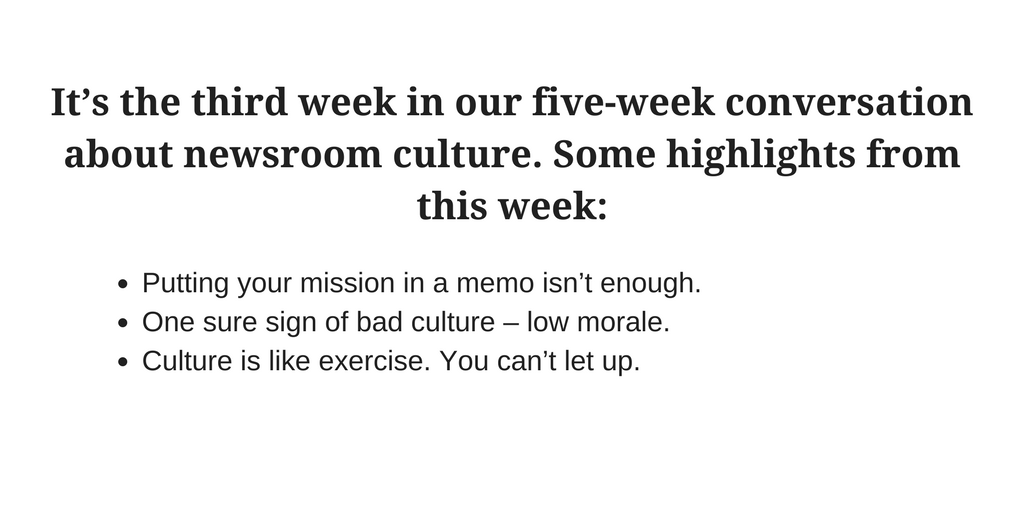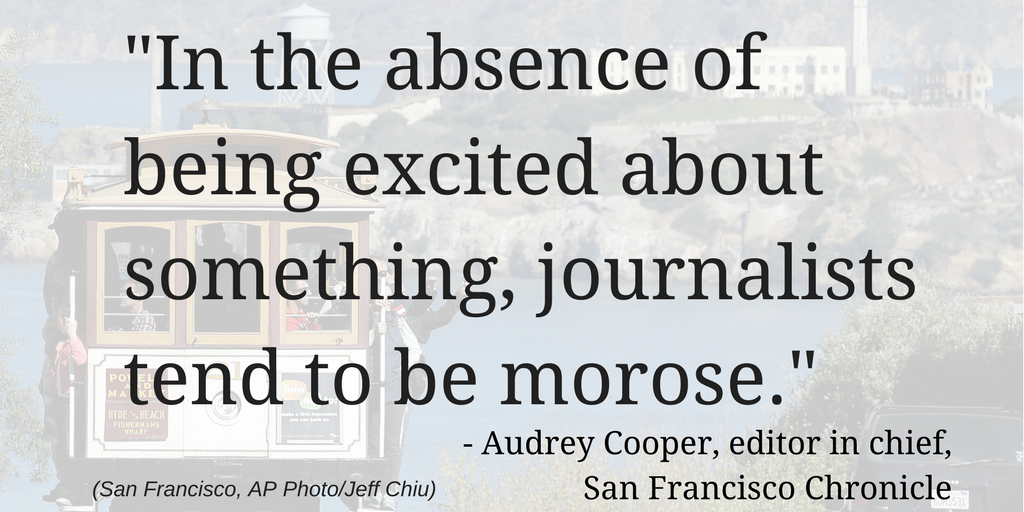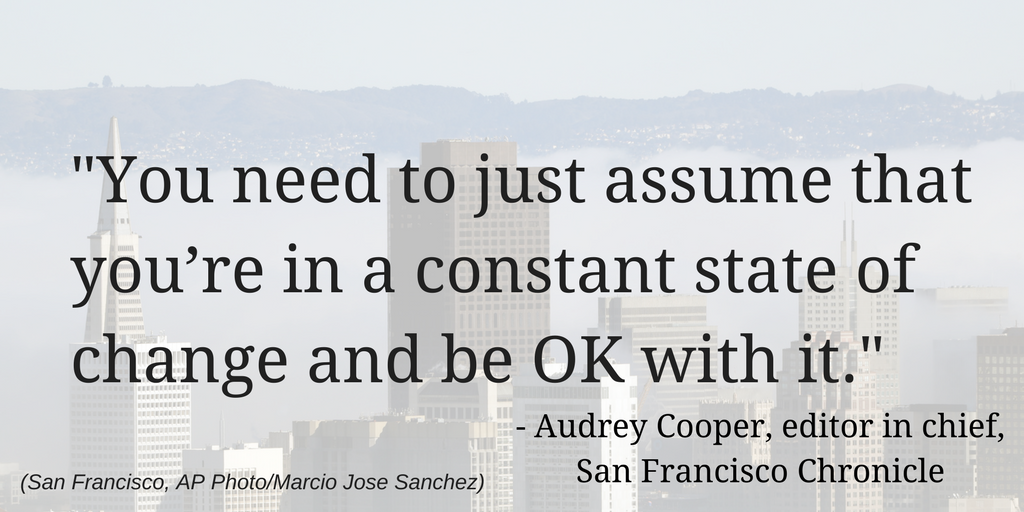This piece originally appeared in Local Edition, our newsletter following the digital transformation of local news. Want to be part of the conversation? You can sign up here.

In every one of her interviews for the editor in chief gig at The San Francisco Chronicle, Audrey Cooper was clear about the thing that needed changing first – the newsroom culture.
“It was the first thing I talked about in all of my interviews,” said Cooper, now The Chronicle’s editor in chief. “People understand that culture is important and sometimes people say, ‘Oh change is really exciting, I really like helping organizations go through change.’ But anyone who’s been through a culture change knows it’s hard, and it can be really miserable.”
Related Training: New Ethics for News Managers
That first year, Cooper said, wasn’t fun. Culture is a hard thing to change, and it’s something that takes laser focus.
We spoke last week about how she took on culture in her newsroom, mistakes she made along the way and why it’s all a bit like parenting. Or fitness.
Our conversation was edited for length and clarity.

You’re not only the first woman to serve as editor of the Chronicle, but also one of the youngest. What can you tell us about what the Chronicle was like when you took over?
I think it was like a lot of newsrooms. There was a lot of distrust and worry about what the future held. I think people knew in a general sense that we had to get digital, but they didn’t really know what that meant or why it was important.
Also, I would say the staff had not really been encouraged to the fullest extent possible to pursue really ambitious journalism. So when I became managing editor, and then acting editor and editor, it was very clear to me that the two things we needed to do were to get everybody understanding what our squad goals were and improving the attitude, which I think came from just a lack of knowing where we were going.
In the absence of being excited about something, journalists tend to be morose.
Tell us about some of the ways that you set culture change in motion.
I think there’s the carrot and the stick. The carrot was I think people did understand what I meant when I said people needed to be more ambitious. So we gave people time to work on really in-depth, long projects and we threw a lot of digital resources at them. And then, when they were completed, we celebrated them to an extent that was almost obnoxious.
I don’t mean this to be disrespectful, but it’s not all together different than what I do with my 5-year-old. You really celebrate when he reads a difficult word or something.
It’s much easier to celebrate than it is to try to beat bad habits out of everybody. It was also about telling people this is what I mean when I say we’re going digital, this is how we’re going to do it, and most importantly, this is how we’re going to help you get there.
So we started our incubator, which physically took people out of the newsroom and put them in a different space to just go experiment. I think a lot of people were afraid initially — well, I know they were afraid initially, when I said we need to try a new thing and not be worried if we fail. There was a lot of, “oh she wants us to be like a startup.”
And I think a lot of that came from a place of thinking that digital meant clickbait, and it doesn’t. But I don’t think everybody understood how you could be digital and not clickbait-y.
Did people hate you?
Yeah.
Well, look, you can call around and find people who are still not members of the Audrey fan club, for sure.
My philosophy is that, as important as anything else, you have to have the right people on your team. And I don’t think that we 100 percent did. I have no tolerance for three things: I don’t have tolerance for unintelligence or lack of curiosity. I have no tolerance for laziness. And I have no tolerance for toxicity. At all.
Luckily we don’t have any unintelligent people, but the toxic people are not there anymore. And I just think that’s so important, because you have one or two toxic people and it spreads.
I’ve had the ability to hire and promote about 65 people since I took over, and I have interviewed every single one of them. I don’t choose who we hire at the end. I give feedback. I let the editors do that. But I am looking to make sure that we don’t bring in any of those people with the problems that we were trying to get rid of.
I’m looking for a very specific type of person when we hire: happy, enthusiastic, willing to try new things, on board with what we’re doing. It’s amazing how much different it is.
I am totally biased. I recognize this. But I think we have one of the happiest newsrooms in the country, and part of that is just being around happy people who are trying cool things.
One of the things I haven’t gotten into yet with this larger conversation about culture is this: What do bad cultures look like, and how do we spot them?
That’s a good question. I think unhappiness, bad morale — and if the first reaction to anything new is all the reasons it can’t happen — that is bad culture.
Think about video. We tried that seven years ago and nobody watched it. And now, if we just said, “Oh, we tried that seven years ago and it didn’t work…”
You need to just assume that you’re in a constant state of change and be OK with it. That’s something we talk about a lot. If this doesn’t work, we’re going to change it. That’s how we go and do things now. We’re just going to be OK, and there’s never going to be a world where you’re not trying to change something.
When you look out at other local news organizations, what things do you think they’re still getting wrong with their culture?
I don’t spend enough time in other people’s newsrooms to say what they’re doing right and what they’re doing wrong. What I do know, and any business leadership class will teach you the same thing, is if you’re not constantly talking about what your mission is and how you’re gonna get there, then people don’t know what you’re doing. And in the absence of information, they’re going to draw their own conclusions.
Our company’s mission is to tell the story of the city of San Francisco, which is a city that is always changing the world. Our newsroom’s mission is to earn new readers, which is another way really of saying get more digital, and to do journalism that makes our community better.
Sometimes I even say “save the world” because I get up on my high horse about it.
But those are the two things that we do, and even my org chart reflects that. I have a managing editor of digital, who is going to get new eyeballs. We have a managing editor of enterprise and investigations, who is in charge of saving the world. So everything we do tracks to one of those goals, preferably both of them.
And when we talk about new initiatives, we talk about how they track to those two goals.
I say it three times a day. You can’t say it too much. You can’t just write it on a memo and think that everybody gets it. It has to become like a religion.
You mentioned parenting earlier, and one of the things I’ve learned with my kids is if I want them to change their behavior, I have to change mine. That’s usually the fastest way. It sounds like that’s what you have done from the top down. It wasn’t just telling people to be happy and telling people to be inspired, it was really modifying what you’re doing in leadership, too, right?
Yeah, and I’m not the most seasoned editor, and I’m really open about the fact that I’m trying to do better every day, too.
I think it’s really important to be vulnerable and open, as much as you can. But also, people aren’t going to come to the editor with every problem. Even though I’ve worked with these people for 11 years, now I’m the scary editor, so they’re going to tell other people.
Having a business partner and having editors and having other people in the newsroom who I know people will go to and will tell me if there are problems so I can fix them is really important to me.
What mistakes do you think people make, including yourself, when they’re trying to change culture? Did you have any early failures?
Yeah…There have definitely been a few times where, in my rush to get things done, I didn’t prime the surface enough, and that scares people.
Tell us something about yourself that your staff doesn’t know.
Oh my gosh, they know everything. I’m a really open book.
I don’t think they know the extent to which I worry about all of them personally. I really worry a lot that they’re happy and healthy and motivated. I worry about that a lot because I have 200 people who depend on me for their livelihoods and jobs and happiness. I take it super seriously.
I don’t know that they see that all the time because I’m very singularly minded sometimes and I can be aggressive. I can be intimidating to people who don’t know me very well.
But I worry about them a lot.
What is the culture like now at The Chronicle?
I think it’s pretty happy.
The worst person you can ask is the editor, you have to ask someone else.
The happiest that I have ever been was when one of our baseball writers put something on Facebook and he said, “when she started talking about all this digital stuff, I thought, oh my gosh, she’s gonna ruin this place and we’re gonna devolve into clickbait. But instead, it’s been a transformation that’s been relevant digitally and we’re doing better journalism than we’ve ever done.”
To have someone who was so suspicious come around and say something on Facebook – who compliments their boss on Facebook? I don’t even think he tagged me in it, it was just a comment about work.
Is this culture change something that gets done and then you can walk away or is it something you have to keep tending?
Oh no. It’s like exercise. You have to do it all the time. All. The. Time. And once you start taking your eye away from it, it devolves into something you don’t want. You can lose control over it very quickly. That’s why I’m still interviewing everybody who comes in.
Also, I don’t think you’ll find any place with a good culture where 100 percent of the people drank the Kool-Aid. That’s probably not possible.
But as long as the influencers are motivated and feel like they’re supported and trying new things, I think that is what is reasonable to expect.

Thank you, Audrey, for the real talk!
Next week is our not-a-journalist week. In the meantime, apply for ProPublica’s Emerging Reporters Program. You can sign up now for AAJA’s annual conference. And Poynter’s News University has a free Webinar on drone journalism.
Thanks for reading!







